Strolling through WinCo annnnnnnnnnnnnd:
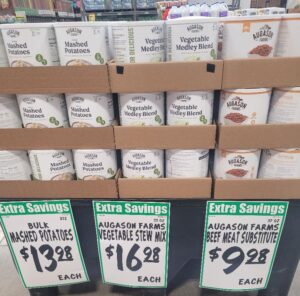
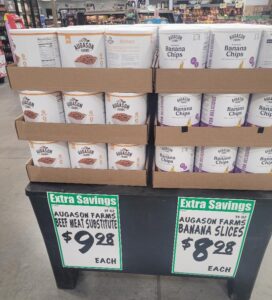
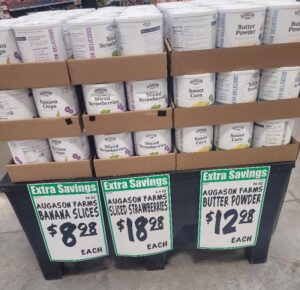
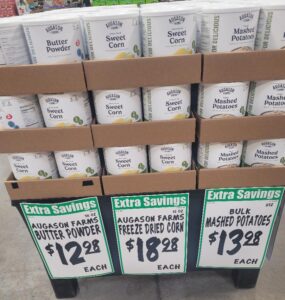 The corn and mashed potatoes are ones I don’t think I’ve seen in the store before. If youre local (or somewhat local) it might be a good time to head over to WinCo and grab a few things.
The corn and mashed potatoes are ones I don’t think I’ve seen in the store before. If youre local (or somewhat local) it might be a good time to head over to WinCo and grab a few things.

I was re-reading some of my earlier posts about canned food and storage food. While we can all agree that pre-packaged food is often not the healthiest thing for you to eat, I think that we can also agree that when you haven’t eaten if three day you’re probably gong to be a little more forgiving of some MSG or high fructose corn syrup in whatever it is you’ve stumbled across to eat.
Making anything ‘from scratch’ using long-life, shelf-stable food is challenging. Yes, you can open a jar of spaghetti sauce, crack open a can of ground beef, and pull some spaghetti out of a box. Presto – dinner is served. But for anything more complex than that, with more than three or four ingredients, you really have to do some careful menu planning.
This website has been one of my favorites since I found it. It is dormant and hasn’t been updated in years, but theres a pretty lengthy list of recipes, with pictures, for all sortsa meal using genuine long-term, shelf-stable stuff. I highly recommend viewing it: Safely Gathered In . And, yup, its from the LDS/Mormons…naturally. I’mm posting about it because although I’ve mentioned it in the past, there’s always a bunch of recent readers who may not have been around when I last linked to it.
I’ve long thought there needs to be some genuine ‘cooking with storage/stored food’ cookbook. Something that wasn’t just theory, but something with actual hands-on cooking, lotsa photos, and solid metrics about quantities, calories, and fuel consumption. I’ve read a few books that tried to be that, and I thought they failed miserably. Mostly because at some point in the recipe, a fresh ingredient was called for. No, I think a cookbook for using nothing but literal sits-on-a-shelf ingredients would fill a void in the preparedness marketplace. It wouldnt make anone rich, but it’d be nice to have.
“Ah, how good it is to be among people who are reading.”
―
Was up at CostCo and beheld this:
Five Day Meal Kit, eh? Hmmm. Lets run some numbers. First, lets grab the data off the back of the box:
So, this is supposed to be five days of food for …I’m guessing one person. Without evidence contrary to that, let’s run with it – five days for one person.
According to the box label, you’ve got a total of fifteen pouches in there. Makes sense, right? Three meals a day for five days is fifteen meals.
The next thing of interest is the caloric value of each meal. This is going to be a tad misleading. Lets take the first item listed on the box…Beef Lasagna. The box says 220 calories. Thats about 1/10th of your daily recommended calories (if you follow USDA guidelines of 2000/k per day). But keep reading…each container is two servings. So, each pouch of that Beef Lasagna is actually 440 calories, or about 1/5th of your daily calories. Slightly better.
So keeping an eye on those calories-per-serving and servings-per-container, you can see that if you add up the entire caloric value of this box you get…an average of 1488 calories per day. Thats about 75% of your daily 2000 calories. And thats 2000 calories for just sitting there doing nothing. Factor in chainsawing downed trees, hanging looters, hauling supplies, etc, etc, and you’ll see that 1488 calories is better than nothing but you better plan on adding a few notches to your belt.
Does that mean that a package like this has no value? Heck, no. I’l take 1488 calories of freezedrieds stored in a 5-gallon-bucket in the back of my truck over the 2500 calories of food that got destroyed/looted/washed away/burned in my house. Something is, usually, better than nothing.
Now, if you took this box, dumped out the pouches and sealed ’em up in a five gallon bucket with some pouches of tuna, packets of oatmeal, instant coffee packets, Gatorade pouches, and maybe a few small cans of Dinty Moore….well…you’re sitting pretty when the dinner bell rings in Heleneville.
The takeaway from this post isn’t that freeze-drieds arent the Perfect Solution. You should already know that. The takeaway here is that you need to read the labels and do the math. Don’t plop down $320 for four of these, stick ’em in a closet, and pat yourself on the back thinnking you, the wife, and kids are now ‘taken care of’.
Two thousand calories per day is a baseline. And there are a lot of people who think that number is of questionable value. Only you know what kinda caloric stockpile will work for you. Run the numbers. Being prepared is sometimes a pain in the butt, but do it anyway. We can all probably stand to miss a few meals and wind up being the better for it, but in a crisis there is very little that calms you down and gets your brain on an even keel more than a tasty hot meal at regular intervals.
So, yeah, pick up some of these at CostCo…at $6 per pouch its not a terrible value. But don’t think youre done once you throw that box in your cart.
As I mentioned earlier, the local WinCo had restocked on Augason Farms food storage. One of the things that was there that I had not seen previously was the cheese sauce. Off the top of my head, the thing that would benefit mostly from this would be the simple meal of macaroni-and-cheese.
The LDS cannery people offer #10 cans full of elbow macaroni, and that stuff keeps quite a while. A case of that, a can of this cheese blend, and you can feed a lot of people without too much fuss. Nutritional value? Probably sketchy. But macaroni-and-cheese will fill up the entire church basement full of refugees without too much fuss. Bonus is that the kids are probably already used to it. Its a no muss, no fuss meal.
So…lets crank a can open and see what we have:
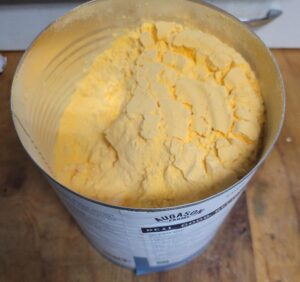 A can of … orange powder. What a shock. Theres a lot in there. There’s also a handful of oxy absorbers hidden in there too. I’m guessing this stuff is pretty hygroscopic, so get what you need and then seal that can back up. The can says to use a 2:1 ratio of water:mix. I followed the instructions and did exactly that.
A can of … orange powder. What a shock. Theres a lot in there. There’s also a handful of oxy absorbers hidden in there too. I’m guessing this stuff is pretty hygroscopic, so get what you need and then seal that can back up. The can says to use a 2:1 ratio of water:mix. I followed the instructions and did exactly that.
 The instructions say to bring the water to a boil and whisk in the mix, stirring for a couple minutes until it thickens. The thickening part seemed to take a while. My suggestion would be to use some of the starch-loaded pasta water to help thicken this stuff. I guess we better make some elbow macaroni to go with this.
The instructions say to bring the water to a boil and whisk in the mix, stirring for a couple minutes until it thickens. The thickening part seemed to take a while. My suggestion would be to use some of the starch-loaded pasta water to help thicken this stuff. I guess we better make some elbow macaroni to go with this.
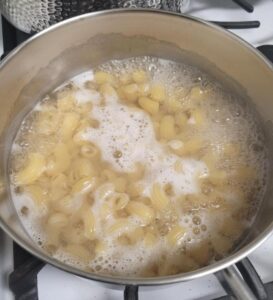 Elbow macaroni is kind of a staple in many storage food pantries. Any interesting shaped pasta should work for this purpose…shells, penne, ziti, orrecchiette, orzo, etc. So, cook up some elbow macaroni until it is al dente, drain, and mix with sauce.
Elbow macaroni is kind of a staple in many storage food pantries. Any interesting shaped pasta should work for this purpose…shells, penne, ziti, orrecchiette, orzo, etc. So, cook up some elbow macaroni until it is al dente, drain, and mix with sauce.
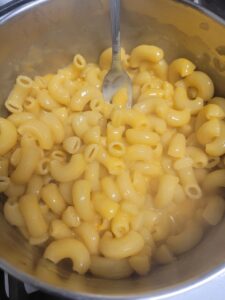 And…thumbs up. It was pretty good. It did need to be a bit thicker but thats easy enough to do. I might throw in a little butter, and perhaps use milk instead of water next time. But, overall…….good product. A little goes a long way, by the way.
And…thumbs up. It was pretty good. It did need to be a bit thicker but thats easy enough to do. I might throw in a little butter, and perhaps use milk instead of water next time. But, overall…….good product. A little goes a long way, by the way.
Definitely good for mac and cheese. Theres a recipe on the can for making a queso dip. Im told that sprinkling this on popcorn would have some appeal as well. For me, it seems like an excellent choice for feeding a buncha people in a hurry with something everyone will like and that doesn’t require a lot of effort. So, yeah…I’ll pick up a couple cans this weekend and tuck ’em away with the LDS cans of elbow mac.
Go. Buy with confidence.
The cheese powder is new…might have to get some to try out for post-apocalyptic mac-n-cheese. Not the price on freeze dried strawberries….$3 per ounce, or $48 per pound. Let me crunch some numbers while you go look at these pictures…..
Strawberries appear to be $3.49/#, or .22/ounce locally. Quick Googling shows that freeze drying strawberries reduces their weight (not volume) by about 88%. So, to get one ounce of freeze dried strawberries you need to start with about 8.33 ounces..or, in other words, a ratio of 8.33:1.
If strawberries are $3.49/#, then 8.33 ounces (52% of a pound) of strawberries would cost $1.81.
So, the can of Augason FD sstrawberries, at 6.4 ounces, contains 3.33 pounds of strawberries before FD processing.
Augason is $3.00/oz for FD strawberries. You can make them yourself for $1.81/oz. You would save $1.19 per oz. At $1600 you would need to make 884 ounces (55#) of FD strawberries for the machine to pay for itself. That would be the equivalent of 138 cans of strawberries.
Obviously the margins, and therefore the returns, on more expensive things like meat would result in ‘paying off’ the purchase of the machine faster.
Something to think about.
A few posts back I mentioned that I had bought a new bunch of Scepter water cans.
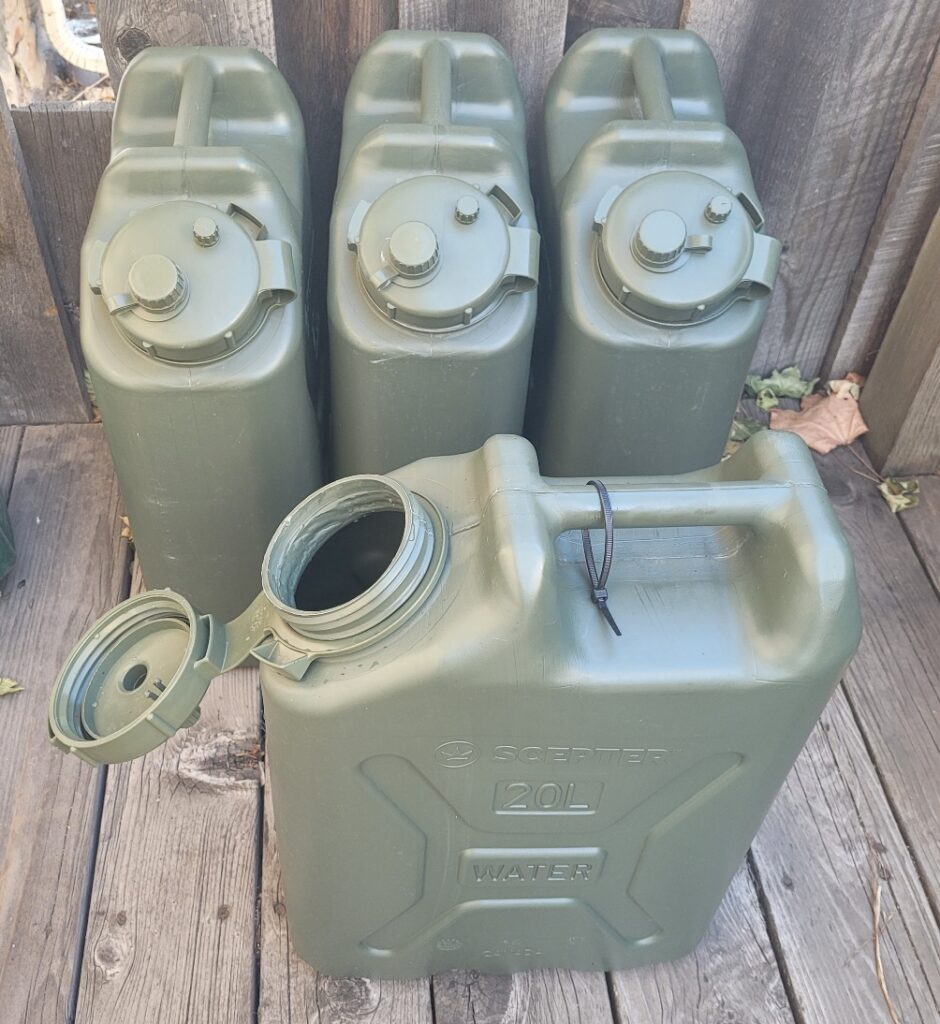 Any new plastic container is going to have ‘that plastic smell’. Also, you don’t know where that container has been or what its been exposed to in its time at the warehouse. So, the smart survivalist will clean these things out if for no other reason than to at least get rid of that unappealing strong plastic smell.
Any new plastic container is going to have ‘that plastic smell’. Also, you don’t know where that container has been or what its been exposed to in its time at the warehouse. So, the smart survivalist will clean these things out if for no other reason than to at least get rid of that unappealing strong plastic smell.
Ten bucks up at CostCo gets you about 14# of baking soda. You don’t need 14# of baking soda to wash out a water jug, but more is better, right? I err on the side of overkill, so I fill a gallon pitcher with hot water, dump in about a cup of baking soda, stir well and dump it into the water jug. Seal it up loosely so water can escape a bit and get the threads of the cap. Shake vigorously, shake some more, and then finally shake it vigorously. I give it about 30 seconds of violent shaking so I can feel the water hitting all the sides of the jug. Don’t be gentle.
Now, if you’re just doing one jug, you can dump out the mix and then rinse the thing out thoroughly with cold water from a hose. But, since I’m doing more than one, I’ll dump the mix into the next jug and repeat the process. I’ll do this for two or three jugs and then use some fresh baking soda/water mix.
Keep in mind, when you dump the water/soda mix out of the jug it will leave traces of baking soda on the inside that will eventually dry to a powdery film. This is why the rinse with clear cold water afterwards.
By this method I either totally eliminate the plastic smell, or reduce it to virtually nothing. And, of course, I’ve now cleaned out the inside of the jug. If you’re a suspenders-and-a-belt guy you may want to disinfect or sterilize the jug afterwards. Thats pretty much the same process but using water/bleach instead of water/baking soda.
And, finally, when it’s time to fill these things you can add all sortsa ‘water preservers’ or bleach to promote storage life. Its my understanding that municipal water (“city water”) is fine to store right out of the tap since it has already been treated by the municipal water provider.
I should also point out that I do this for any large plastic container that I am storing something edible in. My buckets for rice, wheat, etc., also get this treatment. In that case it is imperative that you make sure the bucket is completely bone dry before you fill it with your food product. After cleaning I usually let the bucket/container sit in a dry place indoors for a few days to completely dry out.
Can I get away with not doing any of that and just fill the things up without going through that effort? Absolutely. But this is stuff you’re putting away for a rather dire circumstance. When that dire circumstance occurs (or is occurring) aren’t you going to want every confidence and advantage possible? Of course you will…so spend the ten minutes and do the work. Future you will thank you.
WinCo has restocked on the Augason Farms products.
 I’m pretty well set on these products, but since it’s available and I’m always up for experimentation….lets crack one open and see what we get.
I’m pretty well set on these products, but since it’s available and I’m always up for experimentation….lets crack one open and see what we get.
 What you see in the picture above is two heaping tablespoons of this dehydrated vegetable mix. Its a bit heavy on the potatoes, but there’s a pretty fair representation of everything else in there as well. So, how to rehydrate? Well, let’s just go with the basic of using warm water and time.
What you see in the picture above is two heaping tablespoons of this dehydrated vegetable mix. Its a bit heavy on the potatoes, but there’s a pretty fair representation of everything else in there as well. So, how to rehydrate? Well, let’s just go with the basic of using warm water and time.
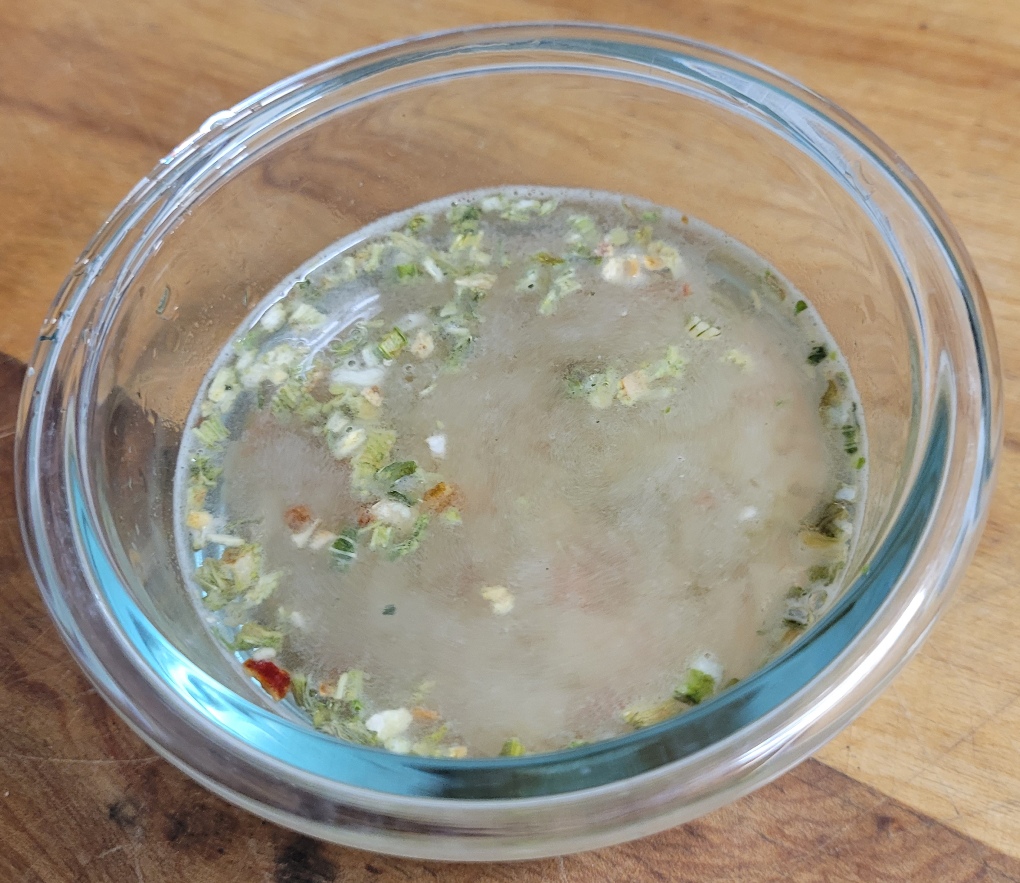 I put in enough warm water to cover, and left to go to work.
I put in enough warm water to cover, and left to go to work.
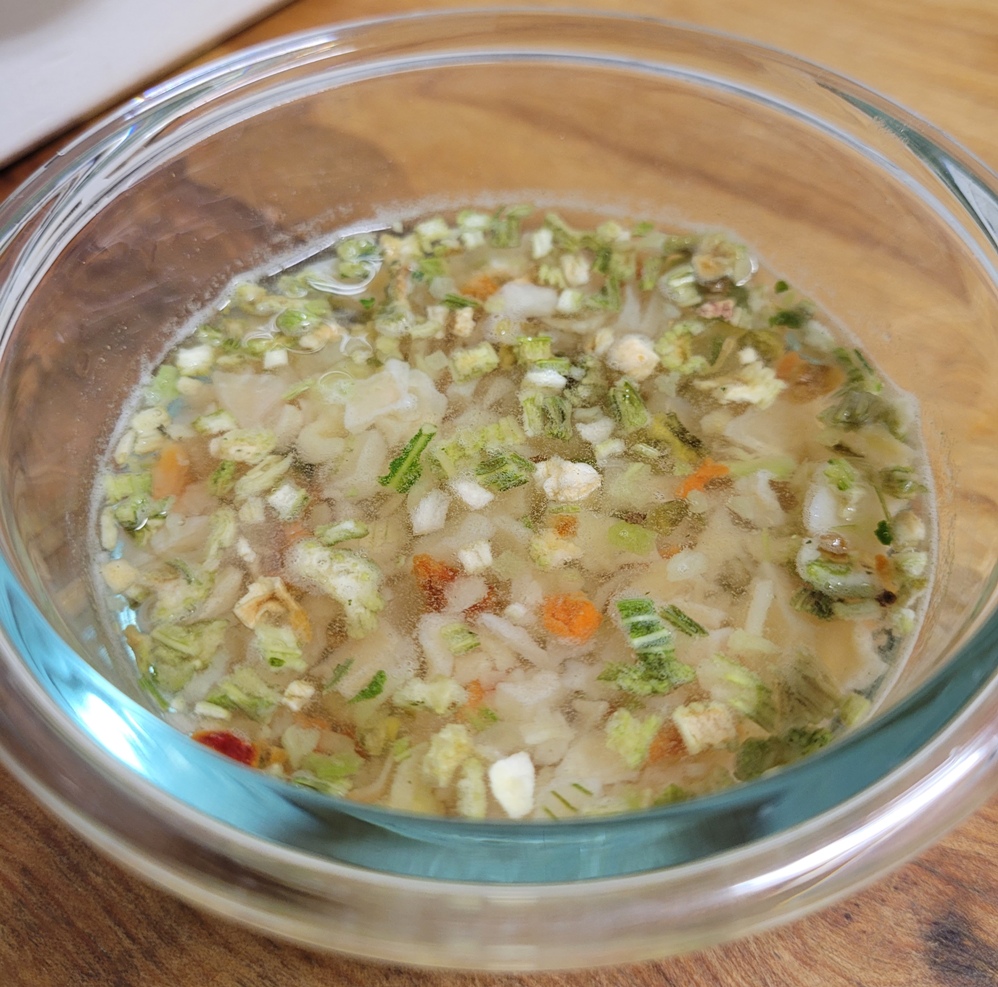 After a little while, t hings start plumping up.
After a little while, t hings start plumping up.
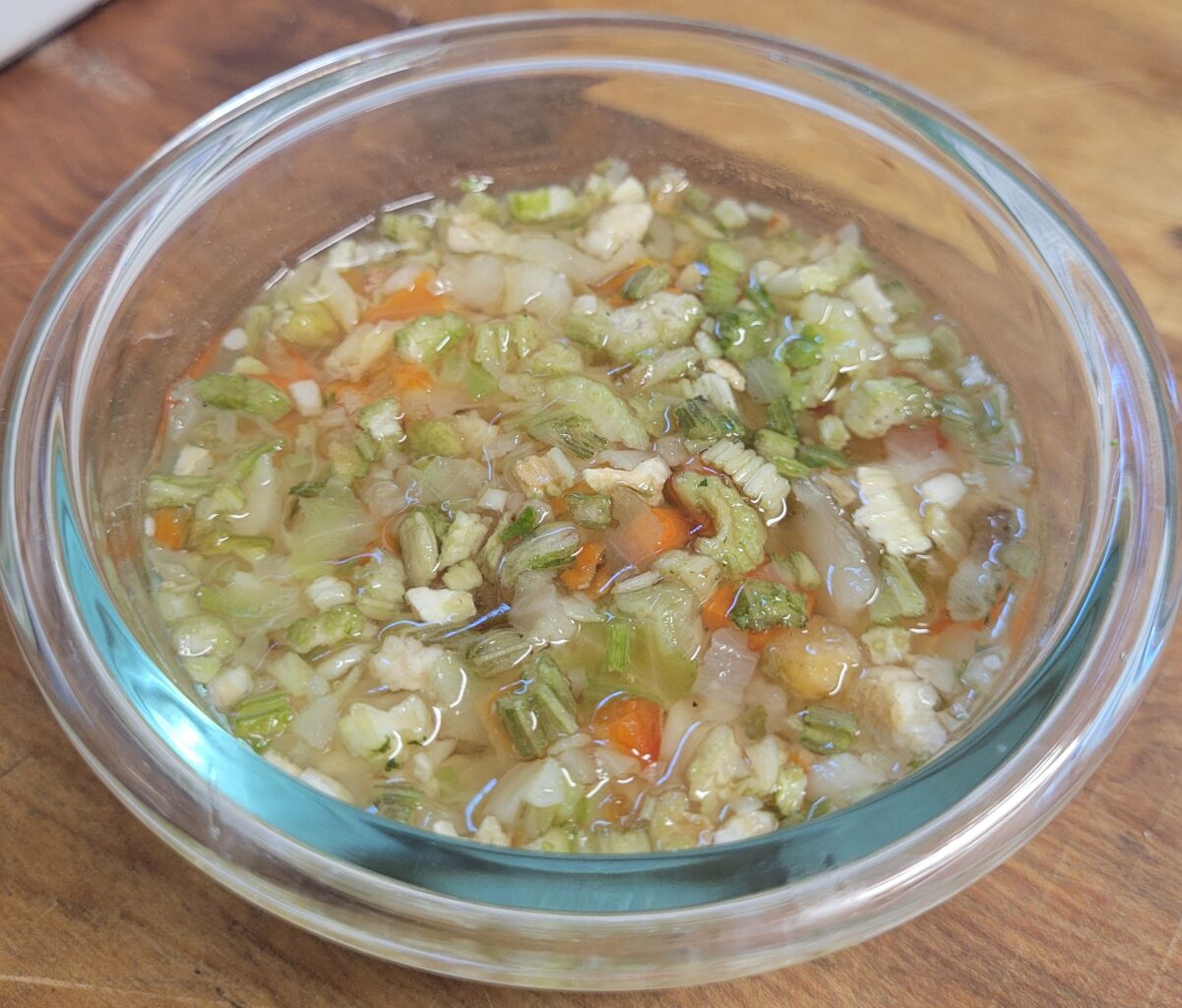 And when I returned to the house at the end of the day, this is what I saw.
And when I returned to the house at the end of the day, this is what I saw.
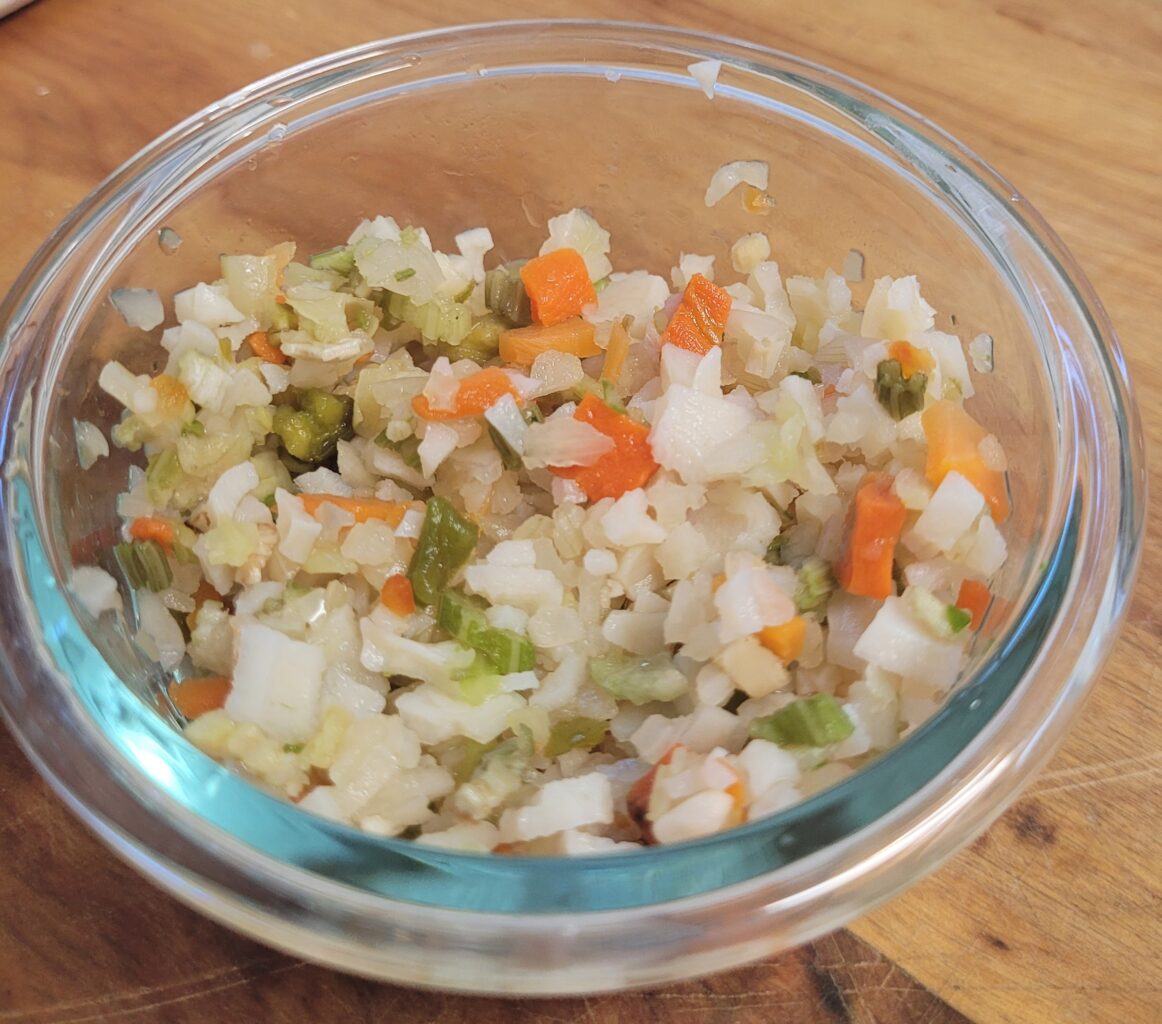 Drained the remaining liquid and this is what remains. The thing that surprised me was just how small these things were cut. When Ii think stew, I think of reasonably hearty chunks of vegetables. Not here. No piece is larger than a thumbnail. This isn’t necessarily bad, it just means you should be aware of it.
Drained the remaining liquid and this is what remains. The thing that surprised me was just how small these things were cut. When Ii think stew, I think of reasonably hearty chunks of vegetables. Not here. No piece is larger than a thumbnail. This isn’t necessarily bad, it just means you should be aware of it.
I’m going to try mixing this up with a can of beef stock, some Keystone beef, and a few other dry ingredients and see what kind of beef soup or beef stew can be created out of entirely long-term foods. I’ll let you know how it works out.
WinCo apparently got in more Augason Farms.Saw these the other day up there:
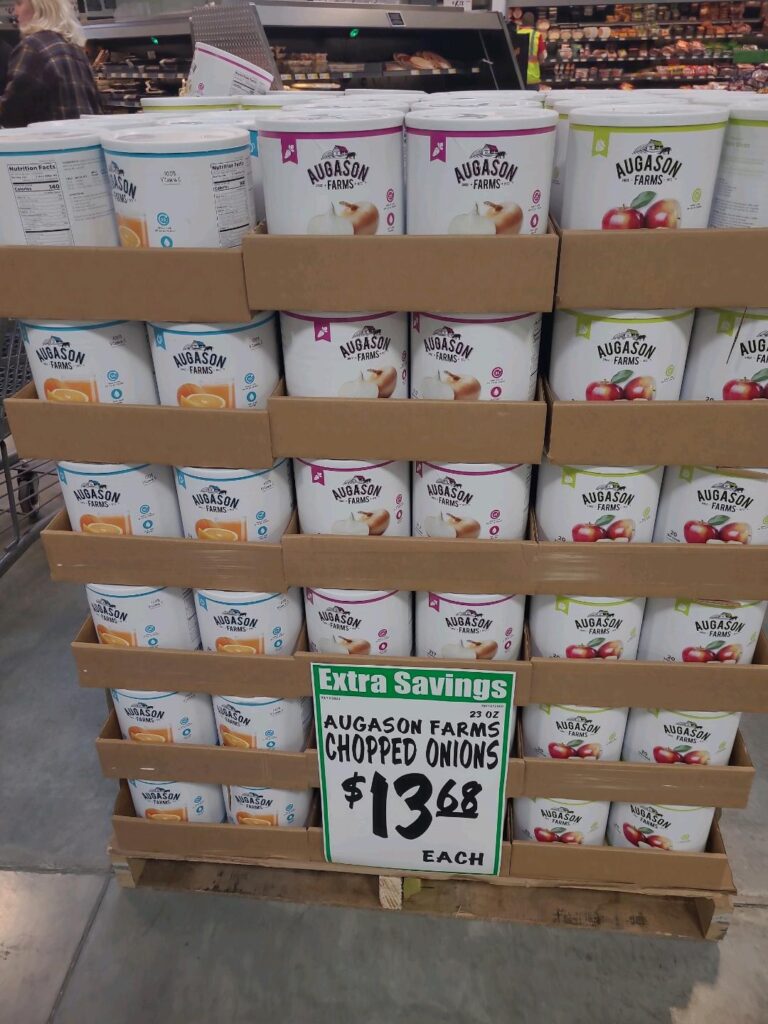

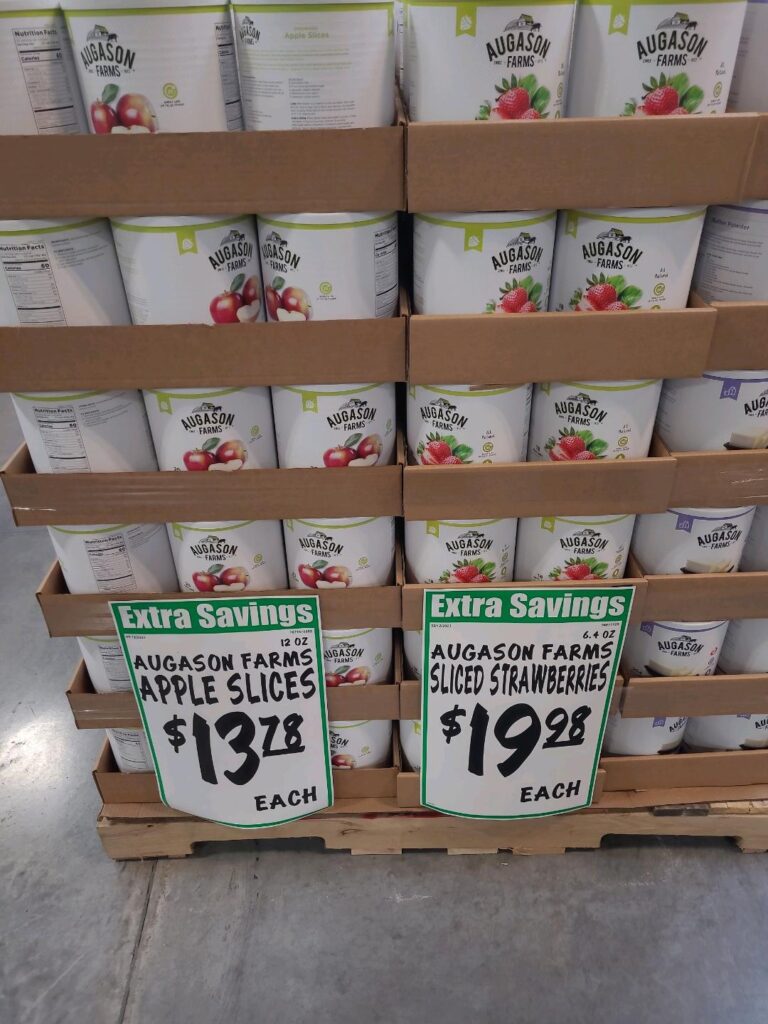

Time to check the inventory and see if I wanna add anything……….
Was up at Winco today and, to my surprise, they had a bunch of Augason Farms. Last time they had the Augason Farms stuff was about nine months ago.
 Not a huge selection, but certainly some good items there to fill in the gaps if youre not quite ready for the upcoming apocalypse. An LMI buddy of mine dragged his feet last time in getting up there and wound up kicking himself about missing out on a couple things. I told him, repeatedly, to not dawdle and get up there….but, he didnt and ha spent the last nine months regretting it. I immediately let him know these were back and that he should take a lunch break from work and go pick up the cans he missed. I also told him that he should let me know if he couldnt get away and I’d do it for him…. Because thats what survivalist buddies do for each other.
Not a huge selection, but certainly some good items there to fill in the gaps if youre not quite ready for the upcoming apocalypse. An LMI buddy of mine dragged his feet last time in getting up there and wound up kicking himself about missing out on a couple things. I told him, repeatedly, to not dawdle and get up there….but, he didnt and ha spent the last nine months regretting it. I immediately let him know these were back and that he should take a lunch break from work and go pick up the cans he missed. I also told him that he should let me know if he couldnt get away and I’d do it for him…. Because thats what survivalist buddies do for each other.
I didn’t pick up anything because…well…I’m Commander Zero and I stocked up on this stuff a long time back. But, I’m tempted to pick up a couple cans of the vegetable stew to try with a couple cans of canned roast beef.
An interesting read on what you have to deal with when the nearest Trader Joe’s, HEB, or Safeway is hundreds (or thousands) of miles away.
Have you actually done menu planning for The End Of The World? I mean, I know you’ve got all sorts of stored food, but have you actually thought about what a particular meal, say breakfast, would look like? I have. For me, breakfast looks like the following:
Thats actually a better breakfast than what I eat now. See, it isn’t enough to just throw back an assortment of storage food. You have to give some thought to what sort of menus youre going to be looking at. How many different breakfasts can you do? Lunches? Sinners? Snacks?
For some ideas, I have always recommended this website and it’s very impressive list of ‘storage food recipes’: http://safelygatheredin2.blogspot.com/2008/11/alphabetical-recipe-list.html
But the important thing to take away from the article listed above is that you have to plan out what your meals will be if you have any hope of efficiently and economically getting your food storage squared away. Go plan a weeks worth of breakfast, lunch, and dinner. How many ingredients ‘cross over’ to other meals? Figure it out, get the most variety and utility from the least amount of items. Its a good exercise.